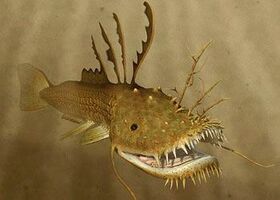
A lurkfish lies in wait, its amazing camouflage making it almost invisible. When it finally pounces, the lurkfish subdues its prey with a huge electrical charge.
The lurkfish is a large, dangerous, electric chondrostean from the Bengal Swamp, in 100 million AD, in the documentary The Future is Wild.
A host of dangerous creatures dwell in the murky backwaters and shallows of the Bengal Swamp, beneath the tangle of thick, chocking vegetation. Perhaps the most dangerous of these is the lurkfish.
At first glance, the scaly surface of the lurkfish could be mistaken for the lumpy bark of a decaying tree trunk, its fins and spines for broken fronds and branches. At 13 feet (4 meters) long and 635 pounds (288 kilograms), it certainly resembles a large log. However, this is no piece of wood, but a very sophisticated and powerful hunter.
For days a lurkfish lies in the water, not feeding, not moving. Being ectothermic, it needs to eat only occasionally. It is an ambush predator, lying in wait. The mouth of a lurkfish splits the whole of its broad snout and from its thick lips hang short barbels that are sensitive to any movement in the water. More barbels sprout from its face. Tall and branched, they mimic the thick tangle of water weeds covering the swamp. But the barbels are not just a means of camouflage. Like the electric catfish which populated tropical Africa and the Nile River during the Quaternary, the lurkfish is able to generate a powerful electric field. The barbels form an electrical sensory net, capable of detecting even the smallest movement of potential prey in the water nearby.
After days of pretending to be a tree trunk, a lurkfish will prepare to attack. It will hold back, waiting until an unsuspecting victim moves to within striking distance. At the sides of its body, the lurkfish's pectoral fins carry muscular spines that dig into the underlying mud and slowly raise the massive front end from the swamp bed. Then its tail paddle, composed of a caudal fin, rear dorsal fin and anal fin, sweeps suddenly and powerfully and thrusts the creature's hungry bulk forwards.
There can be a spray of mud and water from its attacks. The lurkfish's mouth can engulf its helpless victims. Afterwards, a lurkfish then descends into the thick, muddy water of the swamp.
This is a simple hunt for the lurkfish. Small prey is hardly a challenge for this swamp monster. Other means must be employed to subdue larger prey capable of putting up a strenuous and sustained fight. While a larger victim might not escape, it could certainly do severe damage to the lurkfish before succumbing. Like a crocodile, the lurkfish has a mail of thick, protective plates covering its body beneath its skin. This armor shields the lurkfish's internal organs, but its external fins, barbels and sensors are vulnerable in a fight. The lurkfish has another weapon at its disposal. Its electrical system is not just a sensory device but is also used in hunting. A lurkfish can overcome large and combative prey by administering a powerful electric shock to its victim.
Along each side of the lurkfish are stacks of electrical muscles blocks called electrocytes. Separately, these electrocytes are able to generate only a small charge. But hundreds in series along the fish's 13-foot-long body can generate a huge cumulative charge of 1,200 volts (double that of a South American knifefish, such as an electric eel). Whatever the size of the prey, it will be paralyzed or killed by an electric shock of such power. Great jaws will close around the motionless victim, rows of fine teeth will sink into its flesh, and the lurkfish will disappear to dine at its leisure.
Once a lurkfish has struck, the surrounding area of swamp seems to come to life. The disturbance in the water, the splashing noises and electrical signals, all send out the message that danger has passed. The lurkfish has hunted successfully and will rest while it digests its prey.
The Bengal Swamp has become so dangerous, so full of large predators like lurkfish, that some other creatures have taken refuge out of the water. One such animal is the swampus, which can survive on land for up to four days at a time, safe from the electrical attacks of lurkfish. However, once back in the water, it is danger of being killed and eaten by lurkfish.
|
|||||||||
